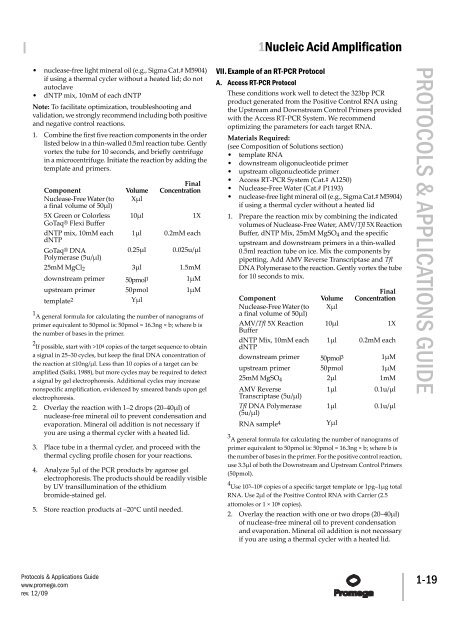Protocols and Applications Guide (US Letter Size) - Promega
Protocols and Applications Guide (US Letter Size) - Promega
Protocols and Applications Guide (US Letter Size) - Promega
You also want an ePaper? Increase the reach of your titles
YUMPU automatically turns print PDFs into web optimized ePapers that Google loves.
| 1Nucleic Acid Amplification<br />
• nuclease-free light mineral oil (e.g., Sigma Cat.# M5904)<br />
if using a thermal cycler without a heated lid; do not<br />
autoclave<br />
• dNTP mix, 10mM of each dNTP<br />
Note: To facilitate optimization, troubleshooting <strong>and</strong><br />
validation, we strongly recommend including both positive<br />
<strong>and</strong> negative control reactions.<br />
1. Combine the first five reaction components in the order<br />
listed below in a thin-walled 0.5ml reaction tube. Gently<br />
vortex the tube for 10 seconds, <strong>and</strong> briefly centrifuge<br />
in a microcentrifuge. Initiate the reaction by adding the<br />
template <strong>and</strong> primers.<br />
Component<br />
Nuclease-Free Water (to<br />
a final volume of 50μl)<br />
5X Green or Colorless<br />
GoTaq® Flexi Buffer<br />
dNTP mix, 10mM each<br />
dNTP<br />
GoTaq® DNA<br />
Polymerase (5u/μl)<br />
25mM MgCl2<br />
downstream primer<br />
upstream primer<br />
template 2<br />
Volume<br />
Xμl<br />
10μl<br />
1μl<br />
0.25μl<br />
3μl<br />
50pmol1 50pmol<br />
Yμl<br />
Final<br />
Concentration<br />
1X<br />
0.2mM each<br />
0.025u/μl<br />
1.5mM<br />
1μM<br />
1μM<br />
1 A general formula for calculating the number of nanograms of<br />
primer equivalent to 50pmol is: 50pmol = 16.3ng × b; where b is<br />
the number of bases in the primer.<br />
2 If possible, start with >104 copies of the target sequence to obtain<br />
a signal in 25–30 cycles, but keep the final DNA concentration of<br />
the reaction at ≤10ng/μl. Less than 10 copies of a target can be<br />
amplified (Saiki, 1988), but more cycles may be required to detect<br />
a signal by gel electrophoresis. Additional cycles may increase<br />
nonspecific amplification, evidenced by smeared b<strong>and</strong>s upon gel<br />
electrophoresis.<br />
2. Overlay the reaction with 1–2 drops (20–40μl) of<br />
nuclease-free mineral oil to prevent condensation <strong>and</strong><br />
evaporation. Mineral oil addition is not necessary if<br />
you are using a thermal cycler with a heated lid.<br />
3. Place tube in a thermal cycler, <strong>and</strong> proceed with the<br />
thermal cycling profile chosen for your reactions.<br />
4. Analyze 5μl of the PCR products by agarose gel<br />
electrophoresis. The products should be readily visible<br />
by UV transillumination of the ethidium<br />
bromide-stained gel.<br />
5. Store reaction products at –20°C until needed.<br />
<strong>Protocols</strong> & <strong>Applications</strong> <strong>Guide</strong><br />
www.promega.com<br />
rev. 12/09<br />
VII. Example of an RT-PCR Protocol<br />
A. Access RT-PCR Protocol<br />
These conditions work well to detect the 323bp PCR<br />
product generated from the Positive Control RNA using<br />
the Upstream <strong>and</strong> Downstream Control Primers provided<br />
with the Access RT-PCR System. We recommend<br />
optimizing the parameters for each target RNA.<br />
Materials Required:<br />
(see Composition of Solutions section)<br />
• template RNA<br />
• downstream oligonucleotide primer<br />
• upstream oligonucleotide primer<br />
• Access RT-PCR System (Cat.# A1250)<br />
• Nuclease-Free Water (Cat.# P1193)<br />
• nuclease-free light mineral oil (e.g., Sigma Cat.# M5904)<br />
if using a thermal cycler without a heated lid<br />
1. Prepare the reaction mix by combining the indicated<br />
volumes of Nuclease-Free Water, AMV/Tfl 5X Reaction<br />
Buffer, dNTP Mix, 25mM MgSO4 <strong>and</strong> the specific<br />
upstream <strong>and</strong> downstream primers in a thin-walled<br />
0.5ml reaction tube on ice. Mix the components by<br />
pipetting. Add AMV Reverse Transcriptase <strong>and</strong> Tfl<br />
DNA Polymerase to the reaction. Gently vortex the tube<br />
for 10 seconds to mix.<br />
Component<br />
Nuclease-Free Water (to<br />
a final volume of 50μl)<br />
AMV/Tfl 5X Reaction<br />
Buffer<br />
dNTP Mix, 10mM each<br />
dNTP<br />
downstream primer<br />
upstream primer<br />
25mM MgSO4<br />
AMV Reverse<br />
Transcriptase (5u/μl)<br />
Tfl DNA Polymerase<br />
(5u/μl)<br />
RNA sample 4<br />
Volume<br />
Xμl<br />
10μl<br />
1μl<br />
50pmol3 50pmol<br />
2μl<br />
1μl<br />
1μl<br />
Yμl<br />
Final<br />
Concentration<br />
1X<br />
0.2mM each<br />
1μM<br />
1μM<br />
1mM<br />
0.1u/μl<br />
0.1u/μl<br />
3 A general formula for calculating the number of nanograms of<br />
primer equivalent to 50pmol is: 50pmol = 16.3ng × b; where b is<br />
the number of bases in the primer. For the positive control reaction,<br />
use 3.3μl of both the Downstream <strong>and</strong> Upstream Control Primers<br />
(50pmol).<br />
4 Use 103–106 copies of a specific target template or 1pg–1μg total<br />
RNA. Use 2μl of the Positive Control RNA with Carrier (2.5<br />
attomoles or 1 × 106 copies).<br />
2. Overlay the reaction with one or two drops (20–40μl)<br />
of nuclease-free mineral oil to prevent condensation<br />
<strong>and</strong> evaporation. Mineral oil addition is not necessary<br />
if you are using a thermal cycler with a heated lid.<br />
PROTOCOLS & APPLICATIONS GUIDE 1-19
















